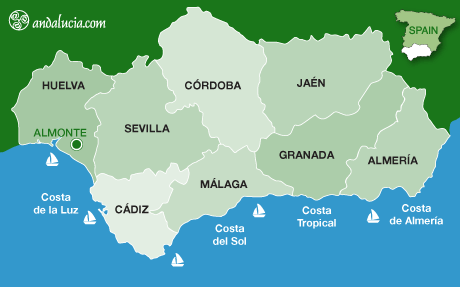Almonte
by Saskia Mier
Almonte is the town better known for the small village in its municipal district and to the south called El Rocío, home to the Virgen del Rocío which receives over a million pilgrims to her Ermita every May. Almonte itself has about 23,000 inhabitants.
HISTORY
Almonte was populated in the Bronze Age and it is suggested the current population sits on a previous Roman settlement.
In the twelfth century it was conquered by Ruiz Gonzalez and in the fifteenth century, brought by the Duke of Medina Sidonia and Count of Niebla. It belonged to the Count of Niebla until Cortes de Cádiz ended the situation.
Almonte was reconquered in the early thirteenth century, incorporating into the Crown of Castille of the Taifa of Niebla, under protectorate regime. In 1264, this Taifa joined the realengo territory of the Kingdom of Seville. In 1369, the Condado de Niebla was created, which did not included Almonte.
In the fourteenth century, Dukes of Medina Sidonia, like the gentlemen of Almonte, finished the confrontations with Niebla and sought out territory united with Niebla, Sanlúcar and Almonte.
Today, Almonte is especially dedicated to agriculture and tourism, as well as having high economic rents based on the exploitation of vineyards, cereals and vegetables. The area has many vineyards where you can find excellent wines, including fruity young wines as well as older wines with more body.
THINGS TO SEE
Iglesia de la Asunción
The church was constructed between the fifteenth and sixteenth centuries and later remodelled during the seventeenth and eighteenth centuries. Located in Plaza Virgen del Rocío.
Ermita de Santo Cristo
The chapel was previously known as Ermita de San Sebastián and dates to the fifteenth century. Located in Plaza del Cristo.
Ayuntamiento
Town Hall, previously Casa del Cabildo, was built between 1586 and 1618 over the footprints of houses obtained by Don Diego de Almonte. Located in Plaza Virgen del Rocío.
Centro Cultural de la Villa
A reasonably new build, the Cultural Centre was built with a chapel style to it and it is here one can find two organisations; the Fundación Almonteña de Bibliofilia y Arte (FABA) and the Fundación Cultura para la Tolerancia. Located in Plaza Fuente de las Damas.
Museo del Vino
The wine museum measuring over 1000m² has been built to explain everything there is to know about local wines produced in the area, from the cultivation of vines to harvest and through to production. Located on Avenida de la Juventud.
Opening Times:
September-June, Wednesday-Sunday, 10:00-14:00hrs and 17:00-19:00hrs.
July and August, Wednesday-Sunday, 10:00-14:00hrs.
Price: 1 euro/person.
Tel: 959 45 10 28
Hotels in Almonte
Book Hotels in Almonte
THINGS TO SEE OUTSIDE THE VILLAGE
Santuario y Aldea de el Rocío
The Ermita de el Rocío (chapel) was built in the fifteenth century and between 1964 and 1969, a surrounding sanctuary was constructed by architects, Antonio Delgado Roig and Alberto Balbotín de Orta, to receive the large numbers of pilgrims. The Gothic style image of the Virgen del Rocío was created in the thirteenth century and is dressed in rich fabrics and surrounded by pure gold decorations. Located on the A-483. More>
NATURAL AREAS
Parque Nacional Doñana
Doñana National Park is considered one of the most important protected natural areas of Europe. Crucial crossroads for bird migration routes between Africa and Europe, it is also the last refuge for many endangered species. El Acebuche to the south of Almonte is an access point and so is Matalascañas. More>
COUNTRYSIDE WALKS
There are two routes that are popular with walkers. Ruta Circuito Hinojos-Almonte-Bollullos: Pinares y Campiña is 49.6km in length and takes 2.5 hours. The other, Ruta Almonte-Bollullos:Campiña is 12km and takes 1.5 hours. Diversions can be made during both routes that will alter the distance and time taken to complete.
GASTRONOMY
The gastronomy found in Almonte combines prime produce of fruits, vegetables, meat and fish with local products made in the area such as wine, oil, juices and honey. Popular dishes include guisos con conejo (rabbit stew), la corvinata en salsa de almendras (corvina in almond sauce), el buche (offal) and alfajores (sweet pastries). However the most well known dish in the area is the caldereta de cordero (lamb stew) which is typically made during the great pilgrimage to El Rocío.
HANDICRAFTS
Due to Almonte being an equestrian area with a great abundance of horses, mules and donkeys, the main craft is saddlery.
FESTIVALS
Fiesta de la Luz
Celebrated the first weekend of Febuary.
La Candelaria
Pilgrimage celebrated in Aldea del Rocío in April/May.
Romería del Rocío
One of the largest pilgrimages in Spain celebrated in May.
Saca de las Yeguas
An old tradition whereby wild mares and foals are herded from the marshes Rocio and Almonte to check them on the 26 June. More>
Feria de San Pedro
Celebrated on 29 June in El Chaparral.
Rocío Chico
Small pilgrimage celebrated 18 and 19 August.
LOCATION
Almonte is located 45km from Huelva. To get there, take the H-31 leaving Huelva and onto the A-49 towards Seville. Take exit 60 onto the A-484 and continue on until you reach Almonte.
